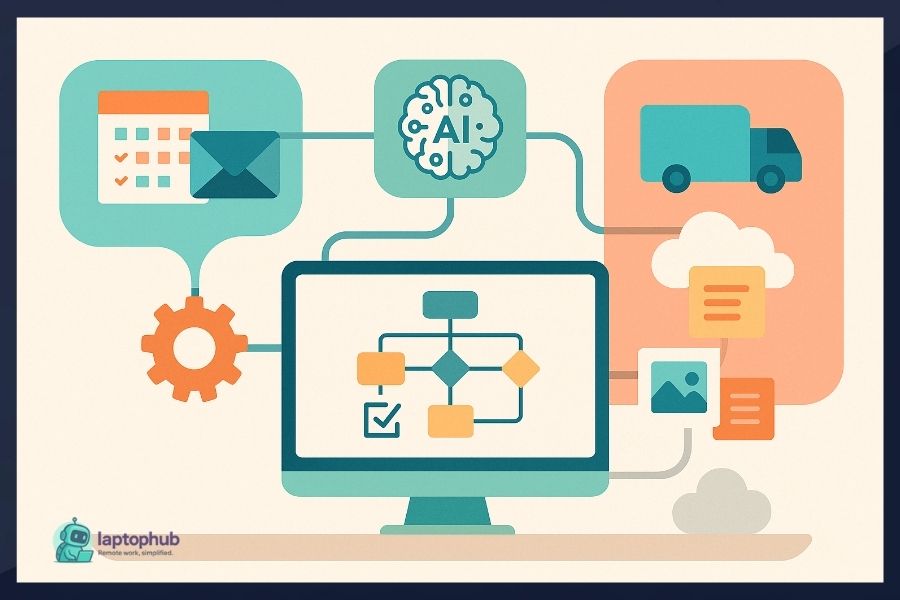Imagine waking up and realizing half of your daily tasks are already done. That’s not wishful thinking—it’s what workflow automation with AI can do for you. Whether you’re running a business, freelancing, or juggling multiple roles, AI can help automate repetitive tasks, organize your processes, and boost productivity like never before. This beginner-friendly guide walks you through how to start automating your workflow using AI tools that require no technical experience—just a willingness to work smarter.
💡Key takeaways:
- AI workflow automation helps save time, reduce errors, and boost productivity by handling repetitive tasks.
- There are user-friendly AI tools available for various business needs, including marketing, customer service, data analysis, and project management.
- Beginners can implement AI in their workflows step-by-step without coding skills using intuitive platforms.
- AI workflow automation is cost-effective, scalable, and essential for staying competitive in the evolving digital landscape.
What is Workflow Automation?
Simply put, workflow automation is using technology to complete tasks with little to no human intervention. These are tasks you do every day—replying to emails, sorting files, data entry—and they eat away your time.
The Traditional vs. Automated Workflow
In a traditional setup, you’re likely juggling tabs, typing repetitive responses, or manually sorting through spreadsheets. With automation, these processes run in the background—accurately, efficiently, and non-stop.
Why Should You Care About AI Workflow Automation?
Because your time is precious—and so is your focus. AI automation helps reclaim both.
Benefits That Go Beyond Time-Saving
- Enhanced Accuracy: AI removes human error from repetitive tasks.
- 24/7 Availability: Bots don’t sleep. They work round the clock.
- Scalability: Automate once, scale infinitely.
- Better Decision Making: With AI crunching data, your insights are sharper and faster.
- Improved Customer Experience: AI chatbots, for instance, provide instant support anytime.
How AI Transforms Business Processes
AI isn’t just a fancy tool—it’s a game-changer.
Real-World Examples of AI in Action
- Email marketing: Tools like Mailchimp and HubSpot personalize messages based on user behavior.
- CRM management: Salesforce Einstein predicts customer behavior.
- Scheduling: AI assistants like x.ai book meetings automatically.
These aren’t theoretical. They’re happening right now—and they’re accessible even to beginners.
Common AI Tools for Workflow Automation
Here’s a quick cheat sheet of AI tools by function:
Marketing
- Jasper.ai: Write emails, ads, or blog posts in seconds.
- SurferSEO: AI-based content optimization.
- Zapier + ChatGPT: Automate your content pipeline.
Customer Service
- ChatGPT or Drift: Intelligent chatbots for websites.
- Tidio: Combines live chat with AI-driven responses.
Project Management
- ClickUp AI: Automates project updates and summaries.
- Notion AI: Notes, tasks, and ideas in one smart workspace.
Analysis
- MonkeyLearn: Extract insights from survey results or social media.
- Tableau + Einstein AI: Visualize and predict data trends effortlessly.
Step-by-Step: How to Automate Your Workflow with AI
Let’s break it down into doable steps.
Step 1 – Identify Repetitive Tasks
Make a list of everything you do regularly. Focus on what’s repetitive, time-consuming, and rule-based.
Step 2 – Choose the Right AI Tools
Pick tools suited for your needs. Avoid feature bloat—simple is often better.
Step 3 – Integrate AI with Existing Software
Use tools like Zapier or Make (formerly Integromat) to bridge your apps.
Step 4 – Test, Monitor, and Improve
Start small, test workflows, gather feedback, and tweak. AI learns over time—so should you.
AI-Powered Automation in Different Industries
Workflow automation with AI is no longer just a tech buzzword—it’s a full-blown revolution across nearly every industry. By leveraging artificial intelligence, businesses can streamline operations, cut costs, and unlock new levels of productivity. Here’s a deeper look at how AI automation is transforming various sectors:
1. Healthcare
AI is automating medical workflows like appointment scheduling, patient follow-ups, billing, and even preliminary diagnosis through chatbots and machine learning models. Tools like IBM Watson Health assist with predictive diagnostics, while robotic process automation (RPA) handles administrative work—freeing up healthcare providers to focus on patients.
2. E-commerce & Retail
From AI-driven product recommendations to automated inventory management and dynamic pricing, the retail sector is maximizing efficiency. Chatbots handle customer service, while AI analyzes purchasing behavior to improve marketing workflows and personalize the shopping experience.
3. Finance & Banking
In finance, workflow automation with AI speeds up processes like fraud detection, credit risk assessment, loan approvals, and customer service interactions. AI-powered robo-advisors even help users with investment planning, making financial services more accessible and efficient.
4. Marketing & Advertising
AI tools like Jasper, Copy.ai, and HubSpot automate content creation, email sequences, social media scheduling, and A/B testing. Marketers now use AI to craft targeted campaigns and track real-time performance analytics, eliminating guesswork and optimizing ROI.
5. Manufacturing
Smart factories are leading the way with AI-driven robotics, predictive maintenance, and supply chain automation. Sensors and machine learning models can detect defects in real-time, schedule repairs automatically, and optimize production lines without human intervention.
6. Education
EdTech platforms are using AI to automate administrative tasks, personalize learning experiences, grade assignments, and even tutor students. Teachers benefit from streamlined grading systems, while students get tailored content recommendations.
7. Legal Services
AI is helping law firms automate contract review, legal research, e-discovery, and case management. Document automation tools and intelligent assistants reduce the time spent on manual paperwork, allowing legal professionals to focus on strategy and advocacy.
8. Human Resources
Recruitment platforms use AI to screen resumes, schedule interviews, and even conduct initial video assessments. Onboarding workflows, benefits administration, and employee engagement can all be automated to improve the employee experience.
9. Real Estate
AI tools help agents automate lead generation, schedule viewings, and provide virtual tours. Predictive analytics can also evaluate property values and market trends, giving professionals a competitive edge.
10. Logistics & Supply Chain
From route optimization and inventory tracking to automated warehousing and demand forecasting, AI is reshaping logistics. Companies like FedEx and Amazon are already using drones and autonomous vehicles in select areas.
Mistakes to Avoid When Automating with AI
- Automating too much too soon: Start with a few tasks and expand gradually.
- Ignoring the learning curve: AI tools require setup and fine-tuning.
- Lack of monitoring: Don’t “set and forget”—track performance.
- Not training your team: Everyone should understand how the tools work.
Best Practices for Getting Started
- Define your goals clearly
- Keep security and data privacy in mind
- Start with low-risk workflows
- Be ready to iterate and improve continuously
Cost vs. Value: Is AI Workflow Automation Worth It?
Absolutely. While some tools come with a cost, the ROI in terms of time saved, errors reduced, and output increased is hard to ignore.
Even free tools like ChatGPT or Google Gemini can offer major value if used creatively.
Workflow automation with AI FAQs
1. Can I automate my workflow without coding skills?
Absolutely. Most AI automation tools like Zapier or Notion AI are no-code or low-code.
2. How much does AI automation cost?
There are free options, and premium tools usually offer flexible pricing—from $10/month to enterprise-level plans.
3. Will AI replace my job?
Not if you evolve with it. AI is here to handle the boring stuff so you can do more meaningful work.
4. What’s the best AI tool for beginners?
Start with ChatGPT for general automation or Zapier to connect tools like Gmail, Slack, and Google Sheets.
5. Is my data safe with AI tools?
Most reputable tools use high-level encryption, but always review their privacy policy and opt for tools with GDPR compliance.
Final thoughts
AI workflow automation isn’t reserved for tech wizards or big corporations. It’s for everyone who wants to stop wasting time on mundane tasks and start focusing on what really matters—creativity, growth, and innovation.
Getting started might feel overwhelming, but the key is to take one step at a time. Identify one task. Automate it. Then another. Before you know it, your workflow will be smarter, leaner, and a whole lot more enjoyable.




